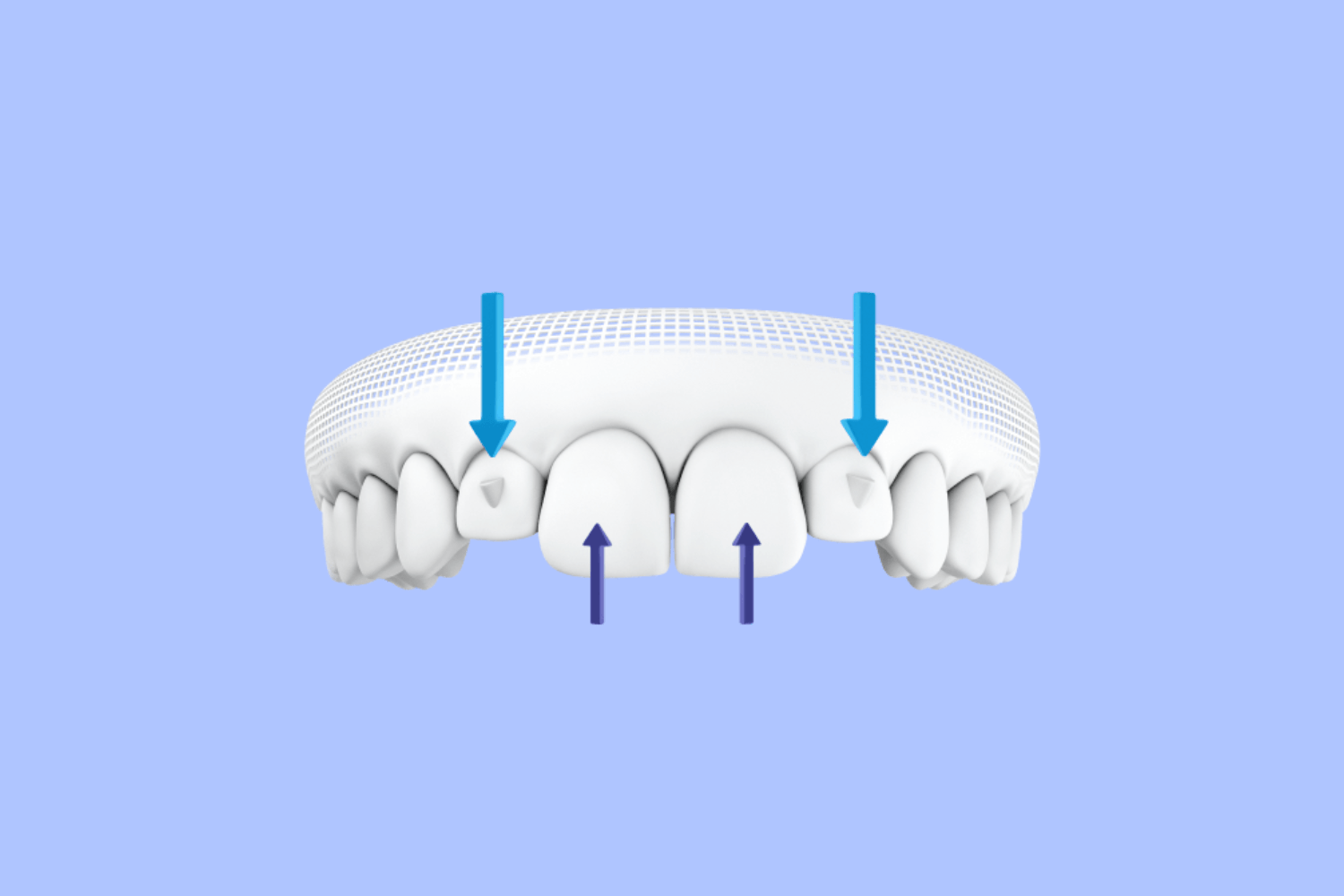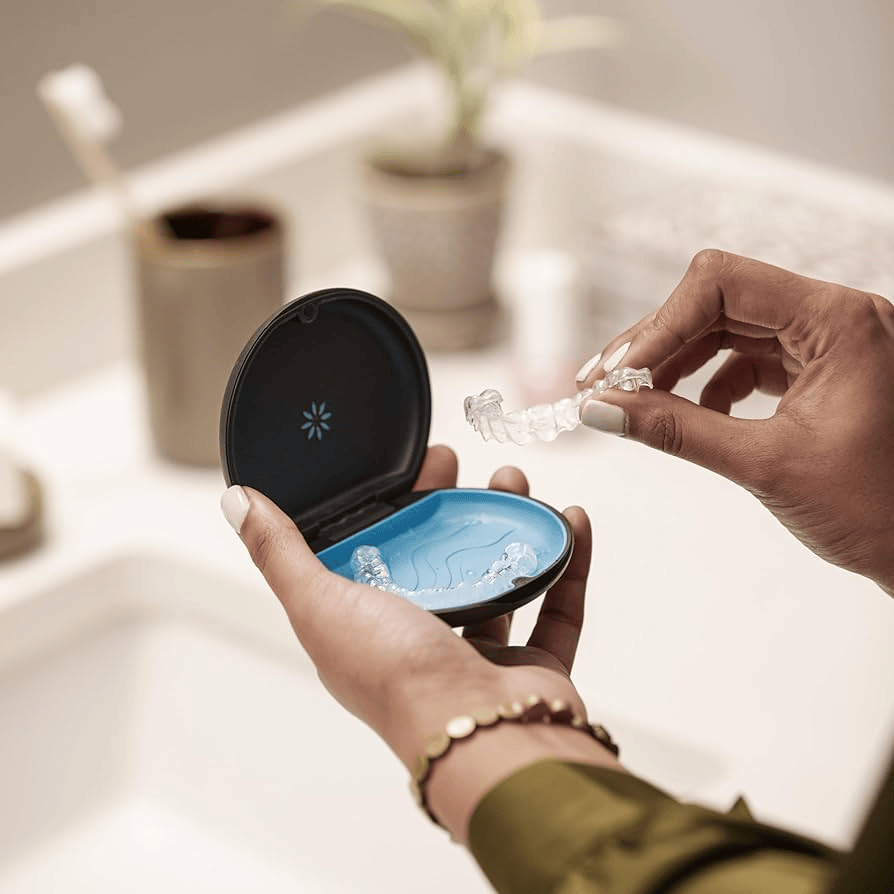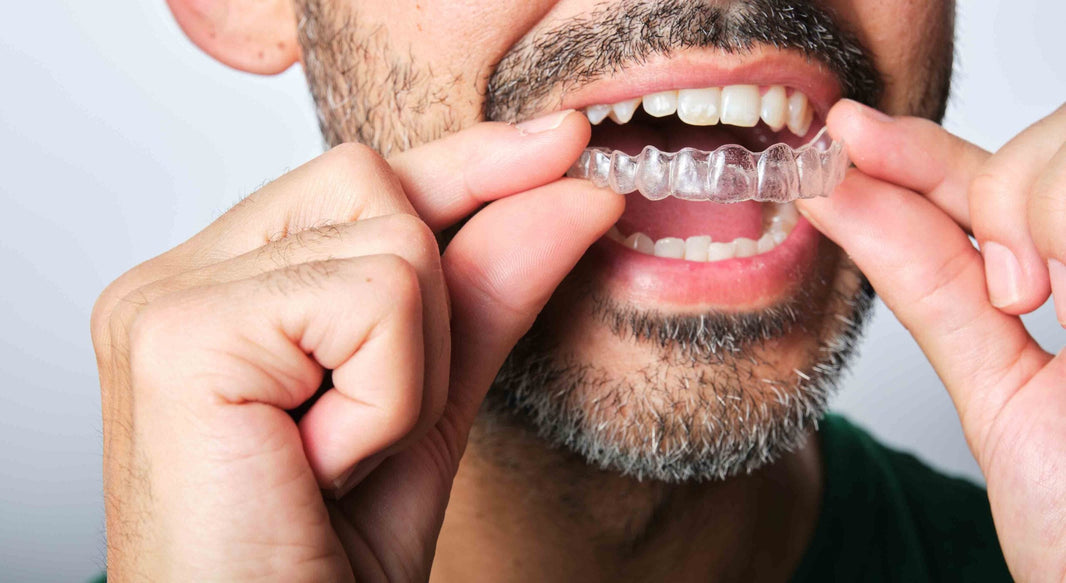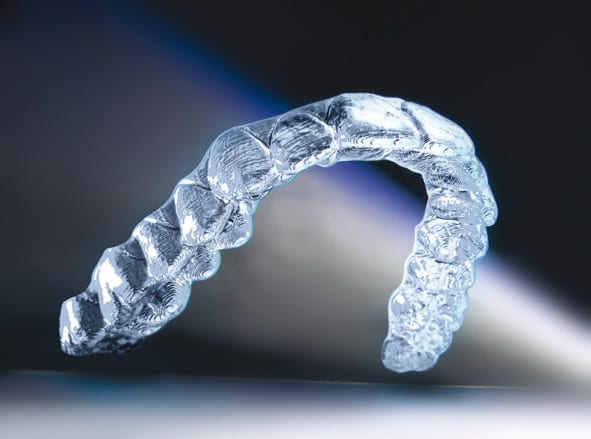Invisalign clear aligners offer a discreet and flexible way to straighten teeth—yet for some patients, additional tools are needed to achieve optimal results. That’s where SmartForce™ attachments (often called Invisalign "buttons") come in. These small, tooth-colored pieces enhance the grip of aligners on teeth, enabling more precise and effective movements. Whether you're new to Invisalign or preparing to begin treatment, understanding how attachments work—and whether you’ll need them—can help you feel informed and ready to succeed.
Table of contents
Invisalign Attachments
How do the attachments on Invisalign work?
Invisalign attachments are small, tooth-colored dots made from dental composite resin. They are bonded to select teeth to give aligners a better grip, making it possible to move teeth with greater precision. Acting as tiny "handles," attachments guide aligner pressure exactly where it’s needed, allowing for movements that would otherwise be difficult with clear aligners alone. They are barely noticeable once in place and fit seamlessly under aligners, making them a subtle yet powerful part of the treatment process.
Key functions of Invisalign attachments include:
Enhancing aligner grip for precise tooth movement
Supporting complex rotations or vertical shifts
Reducing treatment time by improving aligner efficiency
Remaining discreet and blending with natural tooth color
Do you have to get attachments with Invisalign?
Duration of time to wear attachments with Invisalign
Not every Invisalign case requires attachments. Simpler cases involving mild spacing or alignment may be treated effectively without them. However, for movements such as root adjustments, tooth rotations, or vertical shifts, attachments provide the needed control to ensure success. During your consultation, your orthodontist will assess whether attachments are necessary as part of your personalized treatment plan. When used, they typically remain in place throughout your Invisalign journey, helping achieve more predictable and efficient results.

Will Invisalign still work without attachments?
Technically, yes—you can decline attachments. However, doing so may compromise treatment outcomes or extend your timeline. Attachments are carefully planned to support specific movements your aligners alone can’t fully achieve. If you're concerned about attachments for aesthetic reasons or lifestyle preferences, it’s important to discuss this with your orthodontist. They can explain how attachments would impact your results and whether a no-attachment plan is a realistic option for your case.

SmartForce attachments
SmartForce attachments are designed to work in tandem with Invisalign’s custom aligners. Prior to treatment, your orthodontist will apply the attachments using a safe dental adhesive. Each attachment is strategically shaped and placed to deliver force in the right direction, enabling your aligners to move teeth gradually and predictably. This process allows for complex corrections without wires or brackets. Once treatment is complete, attachments are removed easily, leaving your tooth enamel unharmed.
Applying attachments for Invisalign
The application process for attachments is quick and comfortable. Your orthodontist will first prepare the tooth surface and use a dental bonding agent to secure each attachment in its designated location. Once placed, the attachments act as points of leverage, helping your aligners achieve specific movements. Your aligners will be crafted with small "bumps" or indentations to fit perfectly over the attachments and engage them during wear.
Removing Invisalign attachments
When treatment ends, your orthodontist will gently remove the SmartForce attachments using special tools. The dental composite is carefully polished away without damaging your tooth surface. Most patients experience no discomfort during this process—just a mild vibration as the attachments are buffed off. It’s critical that only your orthodontist handles attachment removal, as improper attempts to remove them yourself could damage tooth enamel.

Invisalign Attachments and Pain
What stage of Invisalign hurts the most?
Most patients tolerate Invisalign attachments very well. The application process is painless, and once bonded, attachments feel like a natural part of your teeth. However, some mild discomfort or sensitivity is common when first wearing aligners over newly placed attachments, as your teeth begin to shift. This usually resolves within a few days. Overall, attachments make the Invisalign process more effective without adding significant discomfort—offering a much gentler experience than traditional braces.
Do Invisalign attachments get smoother over time?
If you experience soreness after getting attachments, over-the-counter pain relievers can provide relief during the first few days. It also helps to follow good oral hygiene—regular brushing and flossing prevent plaque buildup around attachments. As your teeth adjust, the sensation of attachments will fade, and aligner wear will become part of your normal routine. Staying consistent with wear time ensures smooth progress and minimizes prolonged discomfort.
Invisalign Attachments Care
Can I brush normally with Invisalign attachments?
Maintaining excellent oral hygiene is crucial when you have Invisalign attachments. Because attachments create small raised surfaces on your teeth, they can become plaque traps if not cleaned properly. Brush your teeth thoroughly after every meal and floss daily to prevent plaque buildup around the attachments. It’s also important to clean your aligners regularly to avoid transferring bacteria to the attachments or enamel. Consistent oral care not only preserves your tooth health but ensures optimal Invisalign results.
How do you get stains out of Invisalign attachments?
Attachments can stain if exposed to dark-colored foods and drinks such as coffee, red wine, or curry. Smoking can also discolor attachments and teeth. While the attachments themselves are made of composite resin, which resists staining to some degree, poor oral hygiene or repeated exposure to stain-causing substances can still cause discoloration. Avoid these habits and rinse your mouth regularly to maintain the discreet appearance of your attachments throughout treatment.
Does Invisalign work better with attachments?
Effectiveness without buttons
Attachments make a significant difference in what Invisalign treatment can achieve. They enable more complex tooth movements that clear aligners alone cannot accomplish, such as vertical shifts or root corrections. Attachments also improve aligner retention, helping trays fit securely and apply force precisely. As a result, treatment becomes more predictable, faster, and effective—delivering results that are comparable to traditional braces in many cases.
Top benefits of using Invisalign attachments include:
- Enhanced grip and aligner control for complex movements
- Improved treatment speed and efficiency
- Greater range of tooth movements achievable with clear aligners
- Nearly invisible design blends naturally with teeth
- Easily removable by your orthodontist at the end of treatment
Invisalign Buttons Popping Off
For decades, braces have been the target of wild pop culture rumors. But science and orthodontic advancements tell a different story. Today’s braces are streamlined, discreet, and incredibly effective. Time to let go of the mailbox stories and embrace the reality: they work—and they’re here to make your life better.
How important are Invisalign attachments?
If an attachment falls off or feels loose, contact your orthodontist promptly. While your aligners will still function, missing attachments reduce their effectiveness and can slow treatment progress. Do not attempt to reattach the piece yourself, as this could damage your teeth. Your orthodontist will rebond the attachment professionally to keep your treatment on track.
Steps to take if an attachment falls off:
Continue wearing your aligners as directed
Avoid trying to fix or remove remaining adhesive
Call your orthodontist to schedule a repair appointment
Maintain excellent oral hygiene to prevent plaque buildup
How to keep Invisalign attachments from falling off?
To minimize the risk of attachments coming off, avoid biting into hard or chewy foods and be gentle when removing your aligners. Use proper aligner removal techniques recommended by your orthodontist—don’t pull unevenly or snap them out quickly. Maintaining good oral hygiene also helps keep attachments secure, as plaque buildup can weaken the adhesive bond.
Tips for keeping attachments secure:
Avoid hard, crunchy, or sticky foods
Follow safe aligner removal techniques
Brush and floss around attachments daily
Attend all scheduled orthodontic check-ups
How do the buttons on Invisalign work?
Invisalign buttons, or SmartForce attachments, are small, tooth-colored bumps bonded to specific teeth to help the aligners exert more precise and targeted forces. These attachments act as anchor points, allowing Invisalign to perform movements—such as rotations or vertical shifts—that clear aligners alone might not accomplish effectively. The decision to use attachments depends on the complexity of tooth movements required in your individual treatment plan, and your orthodontist will place them accordingly to achieve optimal results.
Can you refuse Invisalign buttons?
Patients can choose to decline the use of Invisalign attachments; however, it is important to understand the trade-offs involved. While treatment can still proceed without attachments, certain tooth movements may be less predictable, and overall treatment time may be extended. If you’re considering opting out of attachments, it’s essential to discuss the implications with your orthodontist to ensure realistic expectations about your treatment outcomes.
Do Invisalign buttons stay on the whole time?
In most cases, Invisalign buttons remain on the teeth for the majority—or entirety—of the treatment process. They are typically placed early on and stay bonded throughout your aligner sequence, which generally ranges from several months to over a year, depending on your individual case. Your orthodontist will remove the attachments once treatment is complete or if your treatment plan no longer requires them.
How many Invisalign buttons will I need?
The number of Invisalign attachments needed depends on the complexity of your orthodontic case. For mild cases, only one to three attachments may be required. Moderate cases typically involve four to eight attachments. More complex treatment plans, especially those addressing bite issues or rotations, may require nine or more attachments to provide the control necessary for successful outcomes.
How do you eat with Invisalign buttons?
Although Invisalign aligners are removed during meals, it’s still wise to be mindful of the attachments on your teeth. Opting for softer foods—such as cooked vegetables, ripe fruits, pasta, yogurt, and smoothies—can help minimize pressure on the attachments and reduce the risk of dislodging them. Cutting food into smaller pieces and chewing gently can further protect the attachments, ensuring they remain securely bonded throughout treatment.
Conclusion
Invisalign attachments are a small but powerful component of modern clear aligner therapy. Designed to give your aligners enhanced grip and control, attachments enable more precise and complex tooth movements—helping you achieve the best possible outcome in less time. While they do require a bit of extra care, most patients adjust to attachments quickly and find them easy to manage. Whether or not attachments are needed in your case will depend on your orthodontic goals, and your provider will tailor your treatment accordingly. By understanding their role and maintaining good oral care, you can maximize the benefits of Invisalign attachments and enjoy a straighter, healthier smile.






